Welcome to our second new mathemagical offering for this month. The first one, In My Heart of Hearts: Valentine's Day Special, appeared as one of the current author's Huffington Post pieces.
Six months ago here, in the August 2012 Card Colm Gilbreeath Shuuffling, we considered yet another Gilbreath shuffle variation, a topic we revisit from time to time in August, e.g., see 2005, 2006, and 2009.
In November, magician John Hostler from St. Louis was kind enough to share an exciting discovery of his from last summer which he calls the Triskadequadra Principle (it's pronounced TRISK-a-de-QUA-dra). Below, we present an application of the ideas which just can't wait until next August. While John only develops the principle for four cycling suits such as CHaSeD (Clubs, Hearts, Spades, Diamonds), some version of the key ideas work for cycles of any length. We felt that suitable modifications were appropriate, and came up with an amusing multiple poker hand offering with a kicker at the end.
Thanks to mathematician Neil Calkin of Clemson University for crucial stack refinement input in December.
We leave it to John to explain the Triskadequadra Principle. His recent 24-page booklet The Triskadequadra Principle has all the details, along with some great applications to card magic. The nature of the results obtained bears a resemblance to those discussed in Gilbreeath Shuuffling, and the same mathematical method of analysis explains both principles. Magician and prolific author Karl Fulves had written of related explorations, under the name the "Self-Correcting Set Up" principle, for the shuffling of two packets running Ace—King, in his rare magic insider book Riffle Shuffle Set Ups (originally published in 1968).
The effect below, as well as an examination of the Triskadequadra Principle for cycles of different lengths, putting it in the context of Gilbreath shuffling and known variations, is in Chapter 8 of the upcoming Mathematical Card Magic: Fifty-Two New Effects (A.K. Peters), which is due out in time for MAA MathFest in Hartford, CT.
Flushed with Embarrassment—How It Looks
Gather together five poker players and a poker novice. Hand the latter a packet of cards, and invite him or her to cut it several times, then split it into two and riffle shuffle those parts together, and finally to give it one more cut.Deal out five poker hands for the aficionados of the game, and have each person discard their worst card face down. Retain those five cards in a pile in front of you. Then each player gives his or her best card to the novice.
You then hand over the remainder of the deck, face up, so that the five poker enthusiasts may make free choices to replenish their hands, until they each have five cards.
The resulting poker hands are compared, and it will be seen that some players have done quite well. However, when the novice turns over the cards he or she was given, it's seen to beat the rest, having four Aces and a King.
Just when it seems that the show is over, turn face up the discards you were given earlier. They constitute the winning hand: a straight flush.
A Little Detail
There's one little detail we didn't mention above: we're not playing with a full deck here, not at first anyway.Start by saying, "We'll need just enough cards for some poker hands," as you thumb off or silently count out pre-arranged cards from the top of the deck to form a pile in the other hand. The rest of the deck is set aside for now. "We should shuffle, to be fair," you continue, then address the poker novice. "Would you, please?" Hand that person the packet and have it cut a few times, then split into two roughly equal piles. Have those riffle shuffled and one more cut done.
"You can't ask for fairer than that, can you?" you say, taking the packet back and fanning the card faces, briefly showing the audience, "Completely mixed up."
Now deal them in a circle from left to right, one card at a time per hand, to the poker fans, until you have dealt four hands of five cards. Then look puzzled, and say, "My mistake, there are five of you, not four, sorry." Gather up the cards and deal again, this time into five hands. Comment, "It seems we don't have enough cards here, only four each. I was never very good at numbers. We'll fix that in a moment. First I want each of you to look at the cards you already have. There are probably some good ones, and some bad ones. I'll make you a deal. Get rid of your single worst card you have, just give those ones to me. Please keep all cards face down as you discard them."
Briefly look at the five cards you are given, and comment, "Nothing too high there, oh well," and place them face down on the table in front of you.
Address the poker novice, "Since you're new to the game, we'll give you a break. The rest of you should each donate your best card. Don't worry, you'll have a chance to replace it soon." Have those five cards set in front of the novice, also face down.
"Since the five of you now only have two cards apiece, you may, in turn, go through the rest of the deck here, and find three cards to complement what you have so far. This isn't the way real poker works, I know, but it's fun to do once in a while. Knock yourself out!"
This should generate a buzz of excitement. Hand the remainder of the deck, face up, to the first poker fan, on your left, and in due course to the next one, and so on, until all five of them finally have five cards.
Recap the initial cutting and shuffling of the cards, by the novice, the discarding of low and then high cards, and the complete freedom for each person to pick three cards to add to the two received earlier.
Ask the poker fans, "So, how did each of you fare? It's time to show all!" With any luck, there will be proud displays of full houses, flushes, straights, maybe even a four of a kind. Everyone has at least a pair.
"Amazing, I guess it does help to have free selections for three of your five cards. Let's see how the novice did, purely by chance." The cards in front of the novice are turned over to reveal four Aces and a King. Everyone should be very impressed.
"Incredible!" you exclaim. "You saw the cards cut, shuffled, and cut again. What are the chances that four of you still ended up with an Ace? That's what must have happened, since you each donated your best card."
Here comes the kicker. "I'm not a poker player myself," you add casually. "It's a good thing, too. As mentioned earlier, my cards are all of low value." Turn your cards over, they turn out to be the 2, 3, 4, 5, and 6 of Clubs. "Oh dear, this is rather embarrassing. Isn't that a straight flush?"
Your humble low-valued cards, taken together, do indeed surpass each of the other six poker hands on display. Victory is yours.
A Lot More Detail
The cards you thumb off or count out (the latter action reversing their order) at the start form a stack which you have carefully constructed in advance and planted at the top of the deck. Twenty cards are used, in four interwoven sets of five.List A: 2 of Clubs, 3 of Clubs, 4 of Clubs, 5 of Clubs, 6 of Clubs.

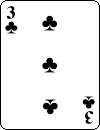
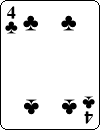
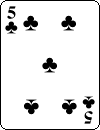
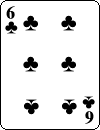
List B: 7 of Clubs, 7 of Spades, Queen of Clubs, Queen of Hearts, Queen of Spades.
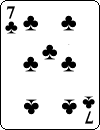
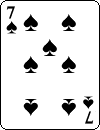
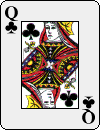

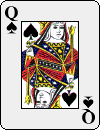
List C: Ace of Clubs, Ace of Hearts, Ace of Spades, Ace of Diamonds, King of Hearts.
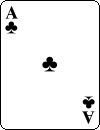
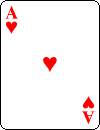
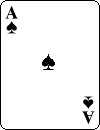
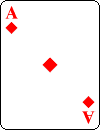
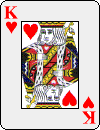
List D: 7 of Diamonds, 8 of Diamonds, 9 of Diamonds, 10 of Diamonds, Jack of Diamonds.
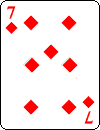
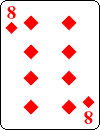

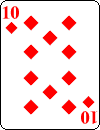

The precise order within each list is not important. Note that the A list has the cards you want, all Clubs, with 6 being the highest value. The C list is the one destined for the poker novice, the lowest card there being a King. The other two lists consist of cards of "middling" value, between 7 and Queen; while they look tantalizing as possible poker hands, neither of them will be taken alive!
Arrange these 20 cards cyclically as ABCDABCDABCDABCDABCD, by which we mean: start with any card from A, then any card from B, one from C, and finally one from D, then repeat in that pattern four more times. It doesn't really matter if you cut off or count out these from the deck at the outset. Also, they may be cut any number of times, for instance just before or after you hand them to the poker novice. This packet is then cut somewhere near the middle, and the two resulting piles riffled together. One more cut is given to the packet.
When you scan the card faces, you are really looking for an appropriate place to cut, so that when you reassemble the two parts the other way, the packet is then in a highly desirable state. Simply cut it between two adjacent cards neither of which are on lists A or C. Thanks to De Morgan's law this is equivalent to the clumsier "both of which are from lists B or D (considered together)." If no such cut is possible, then no such corrective cut is necessary.
Unsuspected by the audience, the result is five stacked quadlets (sets of four adjacent cards) with a special property, due to the Triskadequadra Principle:
Ideally you'd like to dole these quadlets out one at a time, but that's not how poker hands are dealt, so you first deal left to right into four piles of five, then, under the pretext of having made a mistake, collect those piles in the same order and recombine. Dealing once more from left to right, this time into five piles of four, accomplishes your original goal, while seemingly following normal left-to-right dealing conventions.
The upshot is that each of the five poker fans now has a card from the C list, which is the four Aces and one King, and, moreover, all other cards in play at this stage have lower value. More importantly, each of the poker fans also has something from the A list, and these Clubs are the lowest valued cards in hand. As a result, the A list ones will be set aside face down near you, early on, seemingly of no consequence, and then the C list cards will be donated face down to the poker novice, none of these faces being revealed until the end.
That leaves each poker aficionado with two cards from the B and D lists. The best case scenario is that some of them have a pair of 7s or a pair of Queens. Once they are let loose with the rest of the deck, they'll have fun building what they think are strong hands, but it's all in vain. The game has been rigged so that no straight flushes are possible. You will be victorious!
The bogus and somewhat contrived double dealing can be avoided, as John Hostler points out, by simply handing out blocks of four cards to the five poker fans after the shuffle and cut (by the novice) and your own correction cut.
This effect can also be performed as a straight Gilbreath application. In that case, instead of merely splitting the 20-card packet before riffle shuffling, the novice deals about half of the cards to the table, thereby reversing their order. There is extra certainty about the outcome: each of the quadlets is perfect, containing one card from each of the four lists. This may allow for more fun, as there is much flexibility in how lists B and D are chosen.
